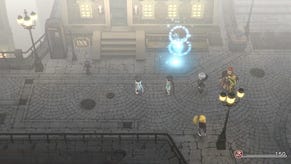I Am Setsuna Has A Few Twists On The JRPG Formula
Hands on with Square's throwback RPG
Due on English-speaking shores this summer, Tokyo RPG Factory's I Am Setsuna is a charming throwback experience with one of the bleakest storylines I've come across. It takes place in a kingdom beset by monsters - if that's really the right word for the excitable penguins and shellfish you'll battle early on - who must be periodically appeased with a human sacrifice. The titular Setsuna is next up for the chopping block, and your task as some random mercenary swordsman is to shepherd the poor girl to the site of her ordained demise - a job you land after failing to murder Setsuna at the request of a mysterious old guy in a forest.
It's not your classic save-the-princess yarn, but during my playtime, it certainly feels like it. I Am Setsuna couldn't be more of a homage to the genre's glory days if it were distributed in tatty cardboard boxes and sold exclusively by rancid import shops in Manchester.
The art direction combines fully animated 3D models with the faded yet opulent palette of Square's Secret of Mana games for the SNES. It's a world of painterly touches, like bunches of dried herbs above fireplaces and foliage that resembles twitching canvas. And then there are the villages, cosy little dioramas of wood and candlelight, where you'll meet people like “Contemplative Young Man” and encounter dialogue like: “Say Mr Protagonist, did you ever visit Dungeon X? I hear Recruitable Character Y likes to go there after stocking up on Healing Item Z". After a few minutes of this, I wanted to change into my pyjamas and play the game under a duvet with a box of cereal.
The combat is modelled on that of Chrono Trigger, the SNES RPG often touted as Square's finest creation - punch-ups take place in the same world as exploration, and enemies can be avoided or bumped into from behind in order to move first in battle. As with Final Fantasy's legendary Active Time Battle system, each character or enemy has an energy bar and can only act once it's full. You can't reposition characters manually, but certain enemies bounce around a bit, which creates opportunities for multikills using area-of-effect spells.
Atop this sturdy old foundation Tokyo RPG Factory has layered a new risk/reward mechanic, the Momentum system, which reminds me of the equally nostalgia-ridden Bravely Default for 3DS. In a nutshell, you can put off acting when a character's energy bar is maxed-out to fill up a second gauge, which is spent on special abilities or used to power up regular attacks with status damage and the like. The trade-off, naturally, is that enemies are free to whale on you while you're accruing Momentum. My mastery of the system wasn't seriously tested during my hour with the game, but I get the sense that later boss battles will teach you to walk the knife-edge between exposing a character to a fatal blow and preparing for a decisive strike of your own.
Unleashing Momentum attacks also increases the likelihood of a Singularity – no, not a point in space where the gravity is so extreme that reality collapses, but a spontaneously occurring group buff. Examples of a Singularity include “Ascendent Shift”, which raises the odds of certain latent “Flux” weapon traits coming into effect. Speaking of weapons, these can be enhanced by combining them with special metals. Its penchant for jargon aside, the game is pretty light on loadout tweaking - you can equip talismans for various boosts but there's no full-body armour customisation, and level-up points are assigned automatically.
Classical Japanese role-players are all about the eccentrics you meet on the journey, and I Am Setsuna has its fair share of grizzled ronin, ninjas and dopey priestesses. But my favourite of the game's travelling companions so far isn't a character at all. He's Tomoki Miyoshi, the composer. Where most peers go in for bloated orchestral numbers, I Am Setsuna's score consists of solo piano tracks, all carefully tailored to the scene. The effect is almost that of watching a silent film with a live musical accompaniment. When you plunge into a brawl, Miyoshi is stiff-fingered and imperious. When you trudge along the coast through a blizzard the melody is plodding and wistful.
It's one of several, gentle ways I Am Setsuna stands apart within the extremely well-trodden confines of the genre. Will it be enough to overcome the game's basic lack of novelty? I'm not sure, but I'm willing to spend a few hours finding out.









